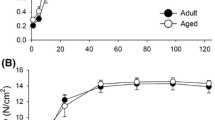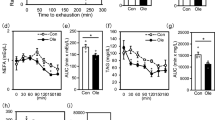Abstract
Skeletal muscle is the main tissue of lipid metabolism and accordingly is critical for homeostasis and energy production; however, the determinants of lipid accumulation in skeletal muscle are unknown. Here, we examined whether the soleus muscle (predominantly slow-twitch fibers) has a higher lipid accumulation capacity than that of the extensor digitorum longus (EDL, predominantly fast-twitch fibers) muscle in mice. Soleus and EDL muscles were harvested from male C57BL/6J mice. The mRNA levels of genes involved in fatty acid import and triglyceride synthesis and accumulation were examined in soleus and EDL muscles. The intramyocellular lipid (IMCL) droplets of muscle cross sections and isolated single fibers were visualized by staining with BODIPY493/503, and fiber types were determined by immunofluorescent detection of myosin heavy chain (MyHC) isoforms. We detected higher mRNA expression of genes related to lipid accumulation in the soleus than the EDL. We also observed a marked increase of IMCL in single fibers from the soleus, but not the EDL, after treatment with a high-fat diet plus denervation. Interestingly, greater accumulation of IMCL droplets was observed in type 2A and 2X fibers (MyHC2A- and MyHC2X-positive fibers) than type 1 fibers (MyHC1-positive fibers) in soleus muscles. These results suggest that the soleus contains more IMCL owing to the higher population of type 2A fibers, and the difference in lipid accumulation between the soleus and EDL could depend on fiber type composition.






Similar content being viewed by others
References
Behnke BJ, McDonough P, Padilla DJ, Musch TI, Poole DC (2003) Oxygen exchange profile in rat muscles of contrasting fibre types. J Physiol 549:597–605. doi:10.1113/jphysiol.2002.035915
Bergouignan A, Trudel G, Simon C, Chopard A, Schoeller DA, Momken I, Votruba SB, Desage M, Burdge GC, Gauquelin-Koch G, Normand S, Blanc S (2009) Physical inactivity differentially alters dietary oleate and palmitate trafficking. Diabetes 58:367–376. doi:10.2337/db08-0263
Bloemberg D, Quadrilatero J (2012) Rapid determination of myosin heavy chain expression in rat, mouse, and human skeletal muscle using multicolor immunofluorescence analysis. PLoS ONE 7:e35273. doi:10.1371/journal.pone.0035273
Bosma M (2016) Lipid droplet dynamics in skeletal muscle. Exp Cell Res 340:180–186. doi:10.1016/j.yexcr.2015.10.023
Cree MG, Paddon-Jones D, Newcomer BR, Ronsen O, Aarsland A, Wolfe RR, Ferrando A (2010) Twenty-eight-day bed rest with hypercortisolemia induces peripheral insulin resistance and increases intramuscular triglycerides. Metabolism 59:703–710. doi:10.1016/j.metabol.2009.09.014
Dickinson JM, Lee JD, Sullivan BE, Harber MP, Trappe SW, Trappe TA (2010) A new method to study in vivo protein synthesis in slow- and fast-twitch muscle fibers and initial measurements in humans. J Appl Physiol (1985) 108:1410–1416 doi:10.1152/japplphysiol.00905.2009
Essen-Gustavsson B, Karlsson A, Lundstrom K, Enfalt AC (1994) Intramuscular fat and muscle fibre lipid contents in halothane-gene-free pigs fed high or low protein diets and its relation to meat quality. Meat Sci 38:269–277. doi:10.1016/0309-1740(94)90116-3
Folch J, Lees M, Sloane Stanley GH (1957) A simple method for the isolation and purification of total lipides from animal tissues. J Biol Chem 226:497–509
Gauthier GF (1979) Ultrastructural identification of muscle fiber types by immunocytochemistry. J Cell Biol 82:391–400
Gueugneau M, Coudy-Gandilhon C, Theron L, Meunier B, Barboiron C, Combaret L, Taillandier D, Polge C, Attaix D, Picard B, Verney J, Roche F, Feasson L, Barthelemy JC, Bechet D (2015) Skeletal muscle lipid content and oxidative activity in relation to muscle fiber type in aging and metabolic syndrome. J Gerontol A Biol Sci Med Sci 70:566–576. doi:10.1093/gerona/glu086
Guo Z, Burguera B, Jensen MD (2000) Kinetics of intramuscular triglyceride fatty acids in exercising humans. J Appl Physiol (1985) 89:2057–2064
Komiya Y, Anderson JE, Akahoshi M, Nakamura M, Tatsumi R, Ikeuchi Y, Mizunoya W (2015) Protocol for rat single muscle fiber isolation and culture. Anal Biochem 482:22–24. doi:10.1016/j.ab.2015.03.034
Louzada RA, Santos MC, Cavalcanti-de-Albuquerque JP, Rangel IF, Ferreira AC, Galina A, Werneck-de-Castro JP, Carvalho DP (2014) Type 2 iodothyronine deiodinase is upregulated in rat slow- and fast-twitch skeletal muscle during cold exposure. Am J Physiol Endocrinol Metab 307:E1020–E1029. doi:10.1152/ajpendo.00637.2013
Meex RC, Schrauwen P, Hesselink MK (2009) Modulation of myocellular fat stores: lipid droplet dynamics in health and disease. Am J Physiol Regul Integr Comp Physiol 297:R913–R924. doi:10.1152/ajpregu.91053.2008
Moro C, Bajpeyi S, Smith SR (2008) Determinants of intramyocellular triglyceride turnover: implications for insulin sensitivity. Am J Physiol Endocrinol Metab 294:E203–E213. doi:10.1152/ajpendo.00624.2007
Pette D, Staron RS (2000) Myosin isoforms, muscle fiber types, and transitions. Microsc Res Tech 50:500–509. doi:10.1002/1097-0029(20000915)
Rakus D, Gizak A, Deshmukh A, Wisniewski JR (2015) Absolute quantitative profiling of the key metabolic pathways in slow and fast skeletal muscle. J Proteome Res 14:1400–1411. doi:10.1021/pr5010357
Rinnankoski-Tuikka R, Hulmi JJ, Torvinen S, Silvennoinen M, Lehti M, Kivela R, Reunanen H, Kujala UM, Kainulainen H (2014) Lipid droplet-associated proteins in high-fat fed mice with the effects of voluntary running and diet change. Metabolism 63:1031–1040. doi:10.1016/j.metabol.2014.05.010
Sacchetti M, Saltin B, Osada T, van Hall G (2002) Intramuscular fatty acid metabolism in contracting and non-contracting human skeletal muscle. J Physiol 540:387–395
Sawano S, Komiya Y, Ichitsubo R, Ohkawa Y, Nakamura M, Tatsumi R, Ikeuchi Y, Mizunoya W (2016) A one-step immunostaining method to visualize rodent muscle fiber type within a single specimen. PLoS ONE 11:e0166080. doi:10.1371/journal.pone.0166080
Schiaffino S (2010) Fibre types in skeletal muscle: a personal account. Acta Physiol (Oxf) 199:451–463. doi:10.1111/j.1748-1716.2010.02130.x
Schiaffino S, Reggiani C (2011) Fiber types in mammalian skeletal muscles. Physiol Rev 91:1447–1531. doi:10.1152/physrev.00031.2010
Schiaffino S, Hanzlikova V, Pierobon S (1970) Relations between structure and function in rat skeletal muscle fibers. J Cell Biol 47:107–119
Shaw CS, Jones DA, Wagenmakers AJ (2008) Network distribution of mitochondria and lipid droplets in human muscle fibres. Histochem Cell Biol 129:65–72. doi:10.1007/s00418-007-0349-8
Spangenburg EE, Pratt SJ, Wohlers LM, Lovering RM (2011) Use of BODIPY (493/503) to visualize intramuscular lipid droplets in skeletal muscle. J Biomed Biotechnol 2011:598358. doi:10.1155/2011/598358
Suzuki M, Shinohara Y, Ohsaki Y, Fujimoto T (2011) Lipid droplets: size matters. J Electron Microsc (Tokyo) 60(Suppl 1):S101–116. doi:10.1093/jmicro/dfr016
Takahashi Y, Shinoda A, Furuya N, Harada E, Arimura N, Ichi I, Fujiwara Y, Inoue J, Sato R (2013) Perilipin-mediated lipid droplet formation in adipocytes promotes sterol regulatory element-binding protein-1 processing and triacylglyceride accumulation. PLoS ONE 8:e64605. doi:10.1371/journal.pone.0064605
Tansey JT, Sztalryd C, Gruia-Gray J, Roush DL, Zee JV, Gavrilova O, Reitman ML, Deng CX, Li C, Kimmel AR, Londos C (2001) Perilipin ablation results in a lean mouse with aberrant adipocyte lipolysis, enhanced leptin production, and resistance to diet-induced obesity. Proc Natl Acad Sci U S A 98:6494–6499. doi:10.1073/pnas.101042998
van Loon LJ (2004) Intramyocellular triacylglycerol as a substrate source during exercise. Proc Nutr Soc 63:301–307. doi:10.1079/PNS2004347
van Loon LJ, Goodpaster BH (2006) Increased intramuscular lipid storage in the insulin-resistant and endurance-trained state. Pflugers Arch 451:606–616. doi:10.1007/s00424-005-1509-0
van Loon LJ, Koopman R, Stegen JH, Wagenmakers AJ, Keizer HA, Saris WH (2003) Intramyocellular lipids form an important substrate source during moderate intensity exercise in endurance-trained males in a fasted state. J Physiol 553:611–625. doi:10.1113/jphysiol.2003.052431
Acknowledgements
We are grateful to the Center for Advanced Instrumental and Educational Supports, Faculty of Agriculture, Kyushu University for the provision of expertise and technical support in the use of the confocal laser microscope Leica TCS SP8. Many thanks to Ms. Akiko Sato and Mr. Shuichi Kitaura (Kyushu University, Japan) for animal care and for help with handling chemical reagents. This work was funded by the Japan Society for the Promotion of Science (JSPS) KAKENHI #26712023 to WM, #15J07972 to YK, and #11J40017 to SS. The cost of English proofreading service was supported by Kyushu University (the program for promoting the enhancement of research universities).
Author information
Authors and Affiliations
Corresponding author
Electronic supplementary material
Below is the link to the electronic supplementary material.
10974_2017_9468_MOESM1_ESM.pdf
ESM 1—IMCL droplets stained with BODIPY493/503 in single muscle fibers isolated from untreated mice, mice treated with either denervation or a 24-h high-fat diet alone, or mice treated with a 24-h high-fat diet plus denervation (HF + Den). Representative images from the mouse soleus (left panels) and the EDL (right panels) are shown. The images of non-treatment and HF+Den are reproduced from Fig. 4 to compare all treatments. Obvious increases of IMCL were only observed in single fibers from the soleus of HF + Den treatment (lower left panel). These obvious increases in IMCL were not found in mice treated with a HF diet or sciatic nerve denervation alone. The prevalence is shown in Table 2. The bars indicate 25 μm (PDF 11536 KB)
Rights and permissions
About this article
Cite this article
Komiya, Y., Sawano, S., Mashima, D. et al. Mouse soleus (slow) muscle shows greater intramyocellular lipid droplet accumulation than EDL (fast) muscle: fiber type-specific analysis. J Muscle Res Cell Motil 38, 163–173 (2017). https://doi.org/10.1007/s10974-017-9468-6
Received:
Accepted:
Published:
Issue Date:
DOI: https://doi.org/10.1007/s10974-017-9468-6




